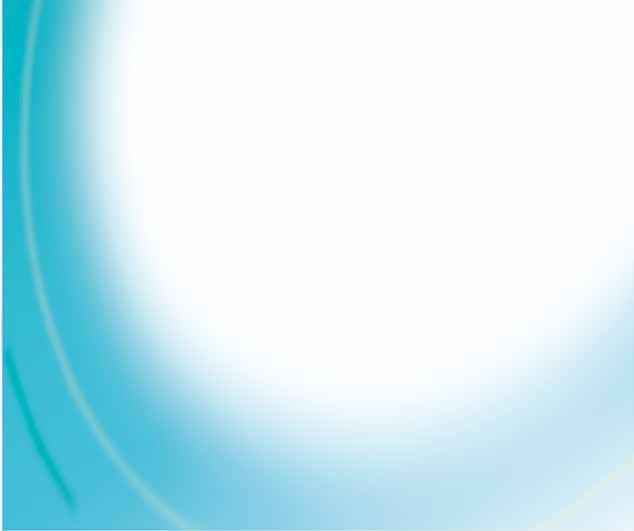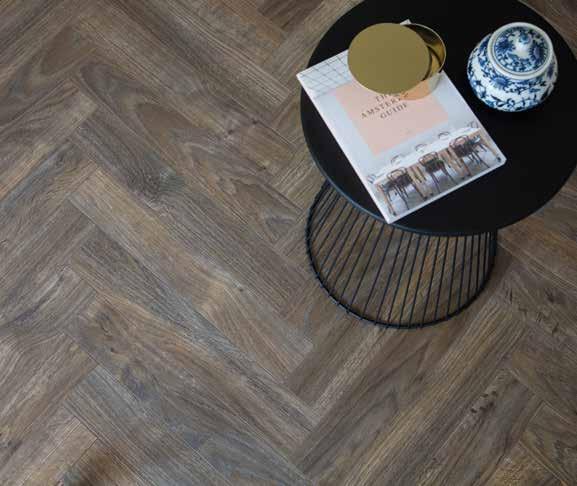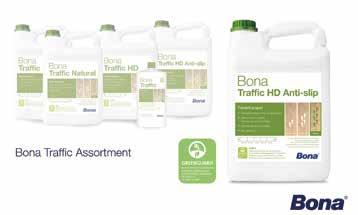
7 minute read
Special Coloured oil and coloured hard wax oil
TAKING ACCOUNT OF THE DETAILS
TIPS & TRICKS FOR MAINTAINING WOODEN FLOORS TREATED WITH COLOURED OIL OR COLOURED HARD WAX OIL
Advertisement
In the previous edition we considered at length the treatment of a wooden floor with oil and with hard wax oil. In the main, we considered firstly when you use (coloured) oil and secondly (coloured) hard wax. In this edition we consider at length the maintenance of floors finished with those oils.
Before you can speak of maintenance, you need to realise how oil and hard wax tackle the wood. The rule of thumb here is that you yourself should be aware that oil saturates the wood and therefore makes it waterproof, but that hard wax does a little bit more. Indeed, hard wax also fills open pores. Filling open pores gives you a floor which both attracts less dirt and is easier to clean.
With general maintenance, there is little difference, if any. For instance, not only can you vacuum clean a parquet floor, but also you can mop it using not too much water. You need to work carefully to avoid scratches and distinguish between oiled and varnished parquet to avoid stains and damage.
Oiled parquet
A general rule of thumb with oiled parquet is that for cleaning it is essential not to use clean water. That might sound strange, but clean water tends to affect the protective coat of oil in the parquet and, as a result, this may give rise to stubborn stains in the parquet. The trick is to mix that water, which should be at room temperature, with a nutritional parquet soap and to make sure that your mop isn’t excessively wet. At the same time it is important to ensure sufficient air circulation so that the water can evaporate quickly and the wooden floor doesn’t have time to absorb it.
Remember, too, that a wooden floor requires extra treatment with a conditioner immediately after the fitting and you should repeat that treatment at least once a year. First of all, you mop as we have explained and then you apply the conditioner without the addition of water. It’s best to do the latter with a micro-fibre cloth and then leave the floor to dry for six hours.
One other point with oiled parquet: It is basically quite easy to remove scratches. To do that, you lightly sandpaper the damaged spot with a fine grain and then spray the floor. The latter gives the pores a chance to open, and then you fill them with oil. You then remove surplus oil with a micro-fibre cloth.
Hard wax parquet
The procedure is largely the same for cleaning parquet treated with hard wax. Besides the standard cleaning for any floor, the big difference is that you can mop a floor finished with hard wax oil with more water than is usual for an ordinary (coloured) oil, but, obviously, without reducing the floor to a mound of ‘suds’! Here, too, you mop in combination with a mopping detergent recommended for the type of floor used.
Subsequently, it is important to apply maintenance oil two or three times per year. If there are signs of wear and tear or foot tracks, you should apply maintenance oil more frequently.
Varnished parquet
There is a bigger difference between varnished parquet and both (coloured) oil and (coloured) hard wax oil. Indeed, you certainly can mop varnished parquet with clean water at room temperature, although we should add a note of caution. It is certainly advisable to add a little parquet cleaner to the water. Moreover, for extra protection and to maintain the colours, it’s best to apply a conditioner to varnished wood at least once per year. This fills in small scratches and prevents the floor from ‘peeling off’. Obviously, if we are talking about a newly laid floor, it is also best to apply a conditioner to the varnished parquet.
Some more helpful advice for removing scratches: Avoid applying lacquer in patches to a parquet floor. The reason for that is quite obvious. It could result in a difference in colour from the rest of the wooden floor. That’s why it’s best to try to fill the scratches with a floor polish first.
What’s on the market ?
Blanchon
The French producer Blanchon is launching ‘Huile Environnement Blanchon’ (oil with respect for the environment) on the market. They have told us from France that this is a real technical revolution in the field of applying oil to parquet. ‘Huile Environnement’ is a fast-drying and non-gloss impregnation which is used to protect parquet, floors,
and stairs. The oil is odourless during the application and drying. Moreover, after less than two hours of drying time, it yields a splendid highly matt surface which can be walked on again. This oil also possesses the European Ecolabel. Blanchon also points out that in France ‘Huile Environnement’ can boast an F.D.E.S. (a standardised document which both shows the results of a life cycle analysis of a product and gives health information). This means it can take part in the A.C.V. (French abbreviation for analysis of a life cycle) of the building as part of the HQE® approach. Since 2020, Huile Environnement Blanchon has had a formula based on biological raw materials in conformity to EN16640.
Bona

Bona has a complete assortment of solutions for coloured floor oil: white, light grey, old grey, or from light to dark, or from dark to light (such as a whitewash effect). Bona parquet oil is available in versions 1K and 2K. The 2K is based on vegetable oils and comprises 19 colours, which are geared to the popular shades. It is the ideal finish for sometimes difficult wood sorts such as kambala, afzelia, and walnut. It can also be used on smoked oak and steamed beech. Bona Craft Oil 2K yields a particularly attractive and water and stain-proof surface and is ready for use after drying for just 8 (Neutral) to 12 hours (Coloured Oil). More colour effects can be obtained in combination with the stains Bona Nordic Tone and Bona Rich Tone Grey. If necessary, Bona Craft Oil 2K can be lacquered over with one of the Bona Traffic parquet lacquers for ultimate protection and convenience.
Chimiver
LIOS HARD WAX BIOIL
LIOS HARD WAX BIOIL is a product containing vegetable ad synthetic oils and beeswax, which gives the wood a natural and uniform appearance, giving excellent water repellency, hardness and softness to the touch. LIOS HARD WAX BIOIL, thanks to its high coverage and its excellent penetrating power, is recommended for all wooden products. LIOS HARD WAX BIOIL complies with EN 71-3 (suitable for toys: the contact with the hardened film is safe for people and animals) and EN 13342. (resistance to chemicals, detergents, coffee). Osmo
Polyx®-Oil : optimal protections for wooden flooring

Osmo Polyx®-Oil Original is a microporous and breathable wood coating that is especially suited to protect wooden flooring. After two coats, the wood surface is water and dirt repellent, hardwearing and extremely durable. Osmo Polyx®-Oil Original is based on natural raw materials that enhance the colour of wood. When dry, the wood coating is resistant to saliva and perspiration and thus also suitable for children’s toys. Osmo Polyx®-Oil is available in different variations: Original, Rapid, Effect, Tints and Pure.
Tover

Tover offers several solutions if your need is a top performing finish that can both protect and colour your wood floor: L’Olio 100% is one of them - a solvent-free oil based on natural waxes and essential oils suitable for high protection making sure you get an excellent resistance to wear and stains with a sole coat. Moreover, it can be easily maintained and renewed. It complies with the DIN-EN 71-3 Standard, which guarantees a safe use on toys and furniture. It ensures a natural, matt and soft aspect and is available neutral and in 30 standard colours. Maxi Oil is another solution, a hard wax modified oil that can be applied by spray or roller in two coats for a rich look and a high resistance to intense traffic. You can choose it transparent in glossy, semi-glossy, matt and extra-matt versions for a incredible versatility.










